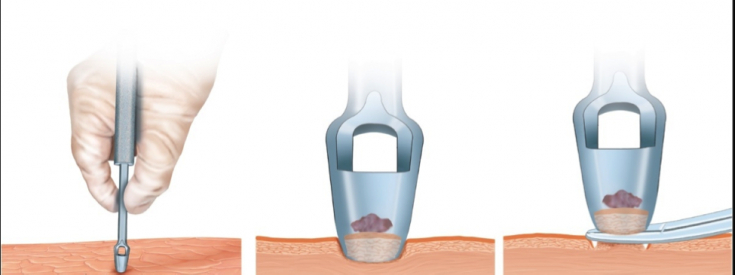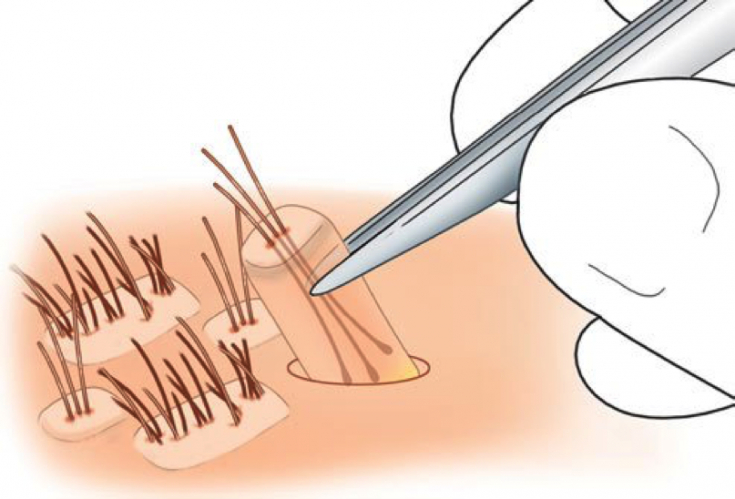According to Vitiligo European Task Force, Vitiligo – acquired chronic discoloration of pigmentation characterized by the presence of well-defined areas of skin depigmentation, which often increase in size over time, associated with the loss of functioning epidermal melanocytes and hair follicle melanocytes. The tactics of treatment are determined taking into account active dermatosis, localization of depigmented areas and the severity of the process. Given the resistance of pathology to traditional therapy, regeneration technologies are also widely used for its treatment<
- Tissue Grafting Techniques for Vitiligo
- Cell grafting for correction of depigmentation areas: options Tissue grafting techniques for vitiligo
Epidermal blister grafting
is based on several- stages. The first step is to stimulate the formation of bubbles on the donor site of the skin by prolonged exposure to vacuum using a syringe without a plunger, to which a three-way connector is attached, to which, in turn, a syringe is attached to create negative pressure.
Read also: Complex therapy of vitiligo
The next step is to cut off the top of the bubble, dividing it into several parts. Next, donor epidermis is transplanted onto a previously
dermabradeddepigmented skin area. After epithelialization is complete, UVA or UVB phototherapy is recommended to stimulate melanocyte proliferation and migration.
Punch grafting
- Punch grafting method consists in performing punch biopsies in the area of
depigmentation of the skin to the level of papillary layer of the dermis at a distance of 3 -4mm apart. Next, the same number of punch biopsies are performed from the donor site and the material is placed on the site -recipient, after which both skin areas are covered with a non-adhesive dressing to absorb the fluid that is released and to immobilize the recipient site. The bandage is removed after a week.

less than 1.2 mm
it is recommended to use ifvitiligo is localized on the face. Repigmentation
occurs near each graft at a distance of 2-5 mm.buttocks or extensor thighs are selected as donor sites. Follow us on
Instagram! The most common side effect of the procedure – paving stone effect.
It is related to the discrepancy between the height of the donor punch and the depth of the hole for it at the recipient site.Read also:
Vitiligo and depressive disorder: is there a link?In this regard, after epithelization
such a skin area will have an uneven appearance, as well as areas of elevation and depression near the transplanted punches.Follicular grafting
- The hair follicle is the reservoir of melanocytes
skin of the scalp of the head measuring 1 cm for harvestingdonor follicles, dividing it into several parts, each of which consists of individual hairs, transplantation to the recipient site with vitiligo and the application of an occlusive dressing for a week.

UVA - or UVB phototherapy.
Read also:
PUVA therapy: modern phototherapy for vitiligo and psoriasisIt is recommended to use this method to restore pigmentation
on the skin of the scalp, in the armpit and inguinalarea, in the eyelash area. Cell grafting to correct areas of depigmentation
This category includesmelanocytesretain their physiological characteristics. The method consists of several stages:
biopsy of the donor site, grinding and trypsinization of the biopsy, cultivation of cell culture and preparation of the recipient site using dermabrasion, CO2 – laser, cell culture transplantation to the recipient site and covering with sterile film for a week. Follow us on
Facebook! The mechanisms of morphological, immunological and immunohistochemical
skin changes in vitiligo are still poorly understood. Despite the widespread use ofphototherapy, methods to increase the functioning of melanocytes and the activity of keratinocytes are poorly developed. Skin repigmentation technologies are highly effective, but require special equipment, costs and highly qualified specialists. More interesting stuff on our
YouTube channel







Add a comment